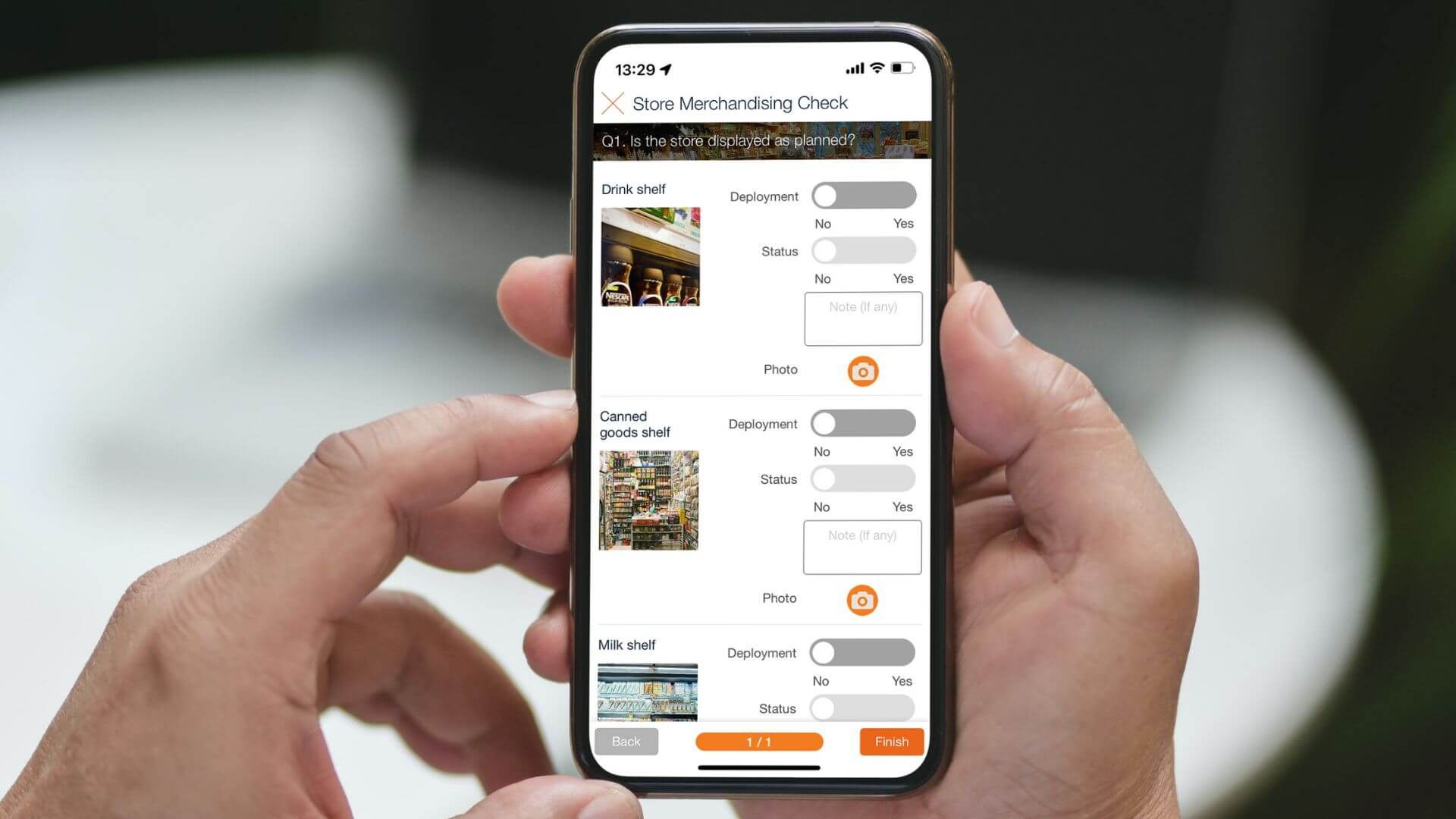Success In Retail: How Japanese Retail Make A Success With DX
It can be seen that digital transformation (DX) becomes an indispensable trend in the world, irrespective of the nature of industries. However, not many businesses now succeed in this term.
Modern trade expansions happen very rapidly in Vietnam. Vietnam modern trade stores are endorsed with the economic growth and the consumer behavior changes. Due to the too harsh expansion, however, we see that the operational excellence is left behind.

Digital transformation trend
Different from the Vietnamese market, Japan has become one of the successful markets that managed to deliver smooth operational flows and systems among chain stores.
FieldCheck have researched how Japanese retail makes a success in retail with DX in today’s article. Are you tempted to know? Let's get the ball rolling.
Do Your Store Staff Maximize Their Performance?
In Vietnam, there are cases that store staff are bored with less attention to their missions. There is a lack of information sharing between headquarters and stores. Stores miss the products/promotional information while headquarters fails to understand what is going on at each store.
Secondly, the store staff lack knowledge to improve the stores’ operations. There is less interaction though the routine works are done.

Low task visibility
Ultimately, supervisors monitor staff in order not to break the rules rather than coaching the employees for better performance.
It can be seen that in Vietnam, the force of store employees have not yet done their best in their tasks. The PDCA cycle is not complete for many reasons.
For example, store staff tend to try to cope with the supervision and management from higher-level personnels without intention to achieve the best results in every single task they were assigned.
Another common symptom is that staff just want to send the reports to fulfill their responsibilities with no story behind each figure mentioned in the report, leading to the failure in success in retail.
Reasons Why Employees Do Not Work Their Best
Regularly, when employees have problems with performance, it is due to other external factors that lead to problems that managers can clearly address such as:
- Missing support and source
- There are no measurable performance goals
- Misunderstanding of organizational vision
- Not enough growth opportunities
- Inadequate job and skills training
- Conflict between team members
- Few opportunities for collaboration between groups
The above factors are beyond the control of the employee. Therefore, management levels need to face the change of culture as well as the management system in the workplace.
While this type of transformation is complicated for your successful retail business, in the long run it will deliver lasting results that help lead your organization to success in retail.
By restructuring your organization's culture to include support mechanisms, feedback opportunities, professional development, and more, you can help employees stay engaged with their work and achieve the goals you set out to achieve.
How Japanese Retail Makes A Success With DX
#1. Store Managers Are Given More Responsibility
In Japan, store managers are given more responsibility as the main personnel to sustain the business success in retail. There are three main responsibilities that are easily noticed in the operations of Japanese fashion stores.
- Necessary information on hand of store managers. Store managers can seize what they need to prepare to maximize the stores.
- More interactions between headquarters and stores. Stores, HQ and supervisors regularly are on mutual good discussions based on common data and information.
- Standardized operations across the stores for stakeholders to compare and refer to good store examples.
There are also more learning opportunities for both managers and staff in the fashion industry in Japan.

Multiple tasks to be handled by Japanese retail managers
#2. Closed Communications Between Headquarters And Store Staff
There are more dense and effective communications between headquarters and stores that accelerate the performance of each other. More communications and understanding are based on valid information.
You can easily check the following process to see how the communication between headquarters and store staff in Japanese fashion businesses.
Solution Based On Japanese Fashion Store Operations
Let’s check out how Japanese fashion stores optimize the performance among stakeholders and employees.
Some Japanese stores implement the system to improve the communications (share, request, evaluate) between headquarters and stores. This trend started from Uniqlo and expanded to the others.
Inspired by Japanese fashion businesses, FieldCheck has developed an one-store platform to support retailers and other business owners to manage their operating activities more easily and efficiently.
We have developed a range of features like digital checklists, location management, real-time analysis, ticket management, time-off, to name a few.
#1. Data Utilization To Enhance The Store Communication
Japanese fashion businesses boast effective and deeper communications between headquarters and each store to maximize the store potentiality and success in retail. With FieldCheck, store staff and managers can share the following content:
Sharing
Sharing the necessary information with the store manager is the very basic things to understand their missions and take responsibilities
- News: Receive the products or promotional information timely/See them anytime to activate their planning
- Learn: Opportunity to learn the things that motivate them to perform better (product skills, company goals, and soft skills)
- Know: Opportunity to view their performance to know how they could perform better.

FieldCheck helps to enhance communication
Request
Task-oriented operations and the effective data collection make the information transparency and business understanding better. Store supervisors request regular reporting from stores to the main best shop front, including the tasks of reporting, survey and to-do list.
- To-do list (Checklist): Consistent to-do list to maintain the store quality for the perfect store making.
- Report / survey: Regular report to update the store performance and issues they face. Feedback collections for the HQ activities (collect voice of store managers)
- Analysis: Opportunity to view the submissions from the stores for the improvement

Task list
Evaluate
The store activities will become more visible by the data. The analysis and evaluations by the managers will help finding out the talents and the advice for the better performance.
- Evaluation: Evaluate the store performance not only from the sales but the other KPI and the task / report submissions.
- Check their actions: Confirm their information receipt by “read” tracking or “survey cooperations”, to follow up with the ones who are not responsive.
- Reward: Reward the good contributors, to encourage their work and as a part of motivations for the staff.
#2. Versatile Checking Tasks In One App
FieldCheck provides consistent task allocation among all the store staff. There are some key features as follows that can help users do best in task management.
- Inventory management
- SKU/Price check (with barcode)
- Merchandise check
- Incident report (photo)
#3. Smart Auditing For The Perfect Store
You can apply digital checklist on field for audit purpose. Its easy scoring feature can provide better understanding for your staff about the tasks. You could share notes or follow-up action among the team.

Audit with ease
#4. Real-Time Analysis For Quicker Actions
There are many risks that you lose your profitability in store operation. This real-time analysis can also minimize your loss with proper communication/management of your store staff.

Real-time activity recording
Should you be interested in the retail audit solution, please do not hesitate to contact us:
Other Ways To Maximize Your Staff Productivity
Besides the above-mentioned methods that Japanese retailers apply to success in retail, there are also other methods that are likely to maximize your staff productivity.
#1. Performance Metrics Analysis
One of the difficulties when managing employee performance is when management fails to recognize bottlenecks in the company's workflow. To get a better understanding of your employees, you can implement regular and consistent employee performance metrics analysis.
This way, you'll gain insight into why your employees aren't meeting their goals and unleashing their full potential at work. In addition, you can also organize performance reviews to find the cause behind the performance metrics.
By knowing the cause, you will be able to build a system with clear goals. From there, you'll be better able to support your employees.
#2. Goal Orientation
When employees have clear expectations, they will be able to focus and have a clear direction on how to achieve those expectations.
To do this, you'll need to establish clear goals so that employees better understand their roles and responsibilities in response to the company's mission.
In addition, visual team workflow maps will also help your employees visualize how tasks are connected and serve the ultimate goal of the organization.
By maintaining the right goal orientation in teams, management can easily measure employees' ability to meet KPIs. In addition, this also helps in real-time support whenever needed.
#3. Active Communications with Purpose
Poor communication between management levels can lead to confusion among employees and cause them to become disconnected from their roles. Therefore, to be able to avoid this problem, you will need to implement an effective communication solution in the work environment.
When your employees can clearly understand their tasks, jobs, and goals, the employee's ability to achieve KPIs will be significantly improved. To do that, you will need to create job descriptions with clear KPIs, which will help employees understand what they will need to do or better organize their work.
Before You Leave
In a nutshell, what sets Japanese retail apart from other markets is the prompt introduction of technology in several critical parts of communications and auditing, analysis and task deployment, leading to provide excellent customer service. These elements are all attributable to the success in retail of this market.
Instead of using traditional methods to conduct tasks like paper-based checklists, or spreadsheet-based management, it is better to apply tech-backed solutions like SaaS products to generate a consistent and smooth workflow across the retailers' operations.




